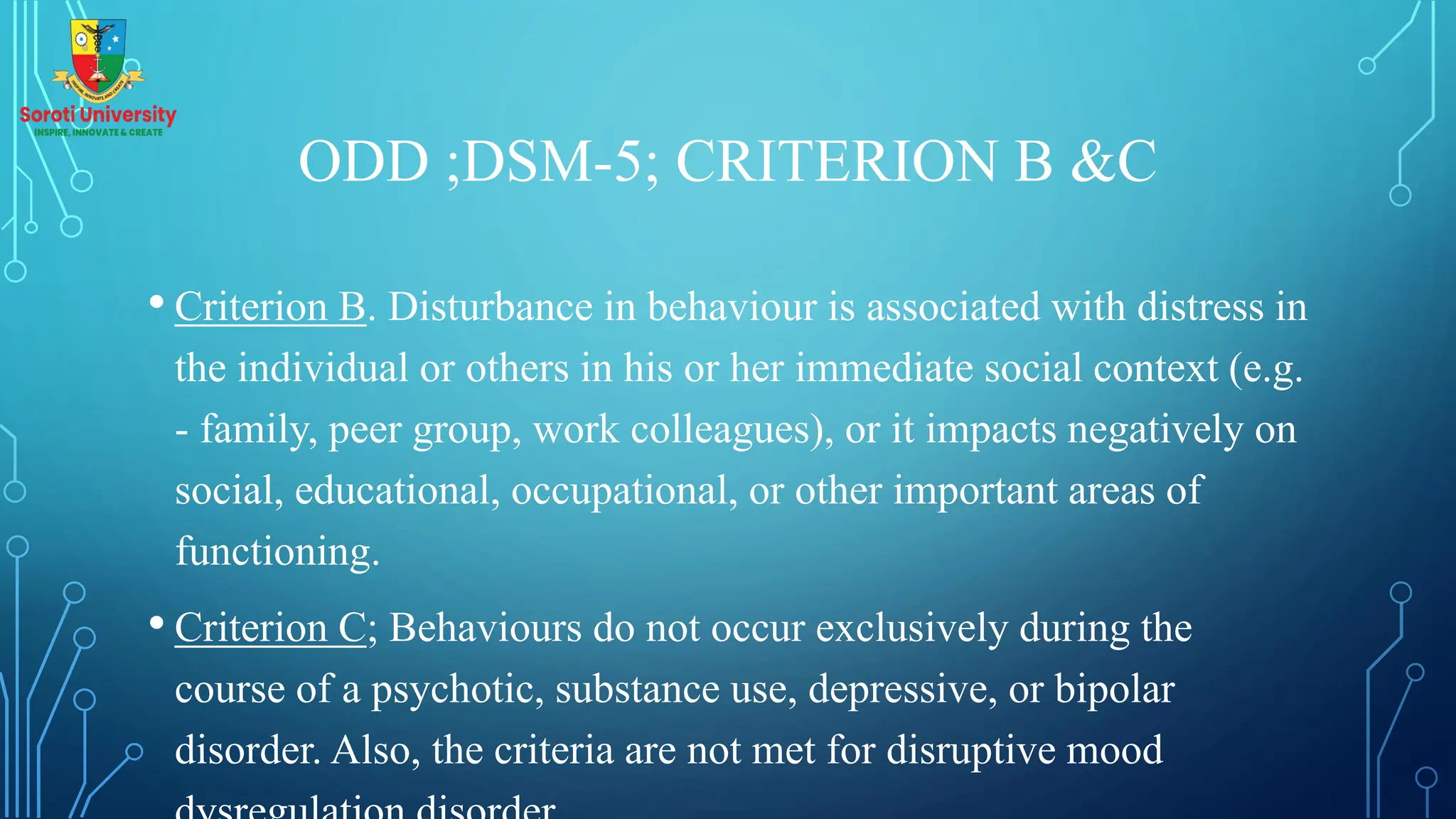This document discusses externalizing disorders among children and adolescents, focusing on attention-deficit/hyperactivity disorder (ADHD) and conduct disorder. It provides background information on the prevalence of mental health problems among children and adolescents in sub-Saharan Africa. It then describes the characteristics and diagnostic criteria for ADHD and conduct disorder according to the DSM-5. The document discusses etiology, negative outcomes associated with ADHD, and treatment approaches including medication and behavioral therapies. Assessment instruments for evaluating ADHD are also outlined.












![ETIOLOGY OF ADHD
Parent-child relationship
• Parents give more commands and have more negative
interactions
• Family factors
Interact with genetic [heritability, (Franke et al., 2009)] and
neurobiological factors
Contribute to or maintain ADHD behaviors but do not cause
them
© 2015 JOHN WILEY & SONS, INC. ALL RIGHTS RESERVED.](https://image.slidesharecdn.com/externalising-disorders-among-child-and-adolescents-presentation-for-bhf-9th-240309101707-1bba3810/75/Externalising-disorders-among-Child-and-Adolescents-_-presentation-for-BHF-9th-06-2023-pdf-13-2048.jpg)
![NEGATIVE OUTCOMES ASSOCIATED
WITH ADHD
• CA with ADHD likely to perform poorly in school than those without
ADHD; similar findings [1,2,3]
• CA with ADHD more likely to have disciplinary school problems than those
without ADHD; similar findings [1,2]
• CA with ADHD is associated with worse social functioning than CA-HIV
without symptoms of ADHD [1,2]
• CA with ADHD are at increased risk for negative outcomes, including
emotional, behavioral problems and social adaptation [1]](https://image.slidesharecdn.com/externalising-disorders-among-child-and-adolescents-presentation-for-bhf-9th-240309101707-1bba3810/75/Externalising-disorders-among-Child-and-Adolescents-_-presentation-for-BHF-9th-06-2023-pdf-14-2048.jpg)































![PROGNOSIS
• Symptoms of ODD can result in frequent conflicts between the
individual and parents, teachers, supervisors, peers, and/or
romantic partners.[4]
• Increased risk for antisocial behavior, impulse-control problems,
substance abuse, anxiety, and depression, when they enter
adulthood(5) APA,2013
• Increased risk for suicide attempts.[6]](https://image.slidesharecdn.com/externalising-disorders-among-child-and-adolescents-presentation-for-bhf-9th-240309101707-1bba3810/75/Externalising-disorders-among-Child-and-Adolescents-_-presentation-for-BHF-9th-06-2023-pdf-46-2048.jpg)
![TREATMENT
• Behavioural Modification; a therapeutic and treatment approach designed to
change a undesirable negative behaviour. By using a system of positive or
negative consequences, an individual learns the correct set of responses for
any given stimulus
• Parent training / parent management training (PMT) / behavioural parent
training (BPT) ; are training programs that aim to change parenting behaviors
and teach positive reinforcement methods for improving children and
adolescent behaviour problems.; It is commonly used for ODD & CD [1][2]](https://image.slidesharecdn.com/externalising-disorders-among-child-and-adolescents-presentation-for-bhf-9th-240309101707-1bba3810/75/Externalising-disorders-among-Child-and-Adolescents-_-presentation-for-BHF-9th-06-2023-pdf-47-2048.jpg)





